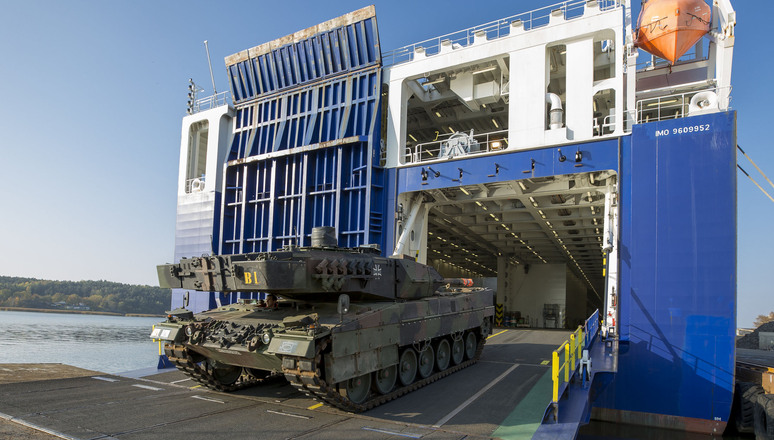Strategic sealift
Since 2003, a group of NATO member countries have pooled their resources to assure access to special ships, giving the Alliance the capability to rapidly transport forces and equipment by sea.

A German Leopard 2 battle tank is unloaded from the Danish roll-on/roll-off ship Ark Germania in the port of Fredrikstad, Norway during exercise Trident Juncture 2018.
- NATO needs to be able to move its forces quickly so that it can respond to any crisis, anywhere across the Alliance. Strategic sealift capabilities allow NATO and Allies to move the right resources to the right places at the right time – including heavy cargo like armoured vehicles, or urgently needed equipment like emergency medical supplies.
- By pooling resources, NATO Allies make significant financial savings and have the potential of acquiring assets collectively that would be prohibitively expensive to purchase as individual countries.
- The Multinational Sealift Steering Committee (MSSC) coordinates NATO’s collective sealift capabilities. It consists of 11 Allies: Croatia, Denmark, France, Germany, Hungary, the Netherlands, Norway, Portugal, Slovenia, Türkiye and the United Kingdom.
- Some of these countries contribute to NATO’s joint strategic sealift capabilities through national capabilities, including full-time charter or nationally owned vessels.
- Others have contributed by funding an Assured Access Contract, which granted the MSSC access of up to 15 special “roll-on/roll-off” (Ro/Ro) ships.
Components
The MSSC provides the Alliance with access to the Sealift Capability Package (SCP), which included up to 15 ships in 2021. The “roll-on/roll-off” ships (commonly called Ro/Ro, because equipment can be driven on and off the ships via special doors and ramps into the hold) are made available from national contributions and from the Assured Access Contract (AAC).
The ships provided to the SCP through national contributions may be made available to NATO for collective sealift purposes if they are not already engaged with national requirements.
The AAC contract, managed by the NATO Support and Procurement Agency (NSPA), guaranteed availability of ships upon request and was financed by six of the eleven signatories (Croatia, Hungary, the Netherlands, Norway, Portugal and Slovenia). This contract was available until the end of 2021.
As an example of the capacity of strategic sealift ships, Danish/German ARK ships and UK Ro/Ro ships can each carry around 2,500 lane metres of vehicles and equipment – in other words, if the vehicles and equipment were parked one behind the other in single file, the line would stretch for 2.5 kilometres.
Mechanisms
Following its establishment in September 2002, the Sealift Capability Package was coordinated by the Sealift Coordination Centre (SCC). In July 2007, this role was taken over by the Movement Coordination Centre Europe (MCCE), based in Eindhoven, the Netherlands. Through improved coordination, the SCC, and subsequently the MCCE, have managed to establish many sealift requirement matches between countries. By making more efficient use of available assets, these countries have made significant financial savings.
Evolution
To overcome the shortfall in Alliance strategic sealift capabilities, a High-Level Group on Strategic Sealift was established at the NATO Prague Summit in 2002. NATO countries agreed to increase their multinational efforts to reduce the strategic sealift shortfalls for rapidly deployable forces by using a combination of full-time charter and multinational assured access contracts.
In June 2003, at the meeting of NATO Defence Ministers in Brussels, 11 ministers signed a letter of intent on addressing the sealift shortfalls on behalf of Canada, Czechia, Denmark, France, Greece, Italy, the Netherlands, Norway, Portugal, Spain and Türkiye.
At the December 2003 meeting of NATO Defence Ministers, nine countries (Canada, Denmark, Hungary, Italy, the Netherlands, Norway, Portugal, Spain and the United Kingdom) signed an agreement to implement the letter of intent, which resulted in the formation of the Multinational Sealift Steering Committee (MSSC).
In February 2004, the multinational consortium, led by Norway, signed a contract with the NATO Maintenance and Supply Agency (NAMSA) – now known as the NATO Support and Procurement Agency (NSPA) – for the provision of the sealift capability.
The countries pursued an incremental approach, using 2004 as the trial year, with the aim of developing further capacity for subsequent years.
At the 2004 Istanbul Summit, the defence ministers of Bulgaria, Estonia, Latvia, Romania and Slovenia signed a supplementary letter of intent on strategic sealift, where they declared their intent to improve strategic sealift and to provide additional sealift capacity for rapidly deployable forces.
During the period 2004-2020, seven countries left the strategic sealift initiative and four countries (Croatia, France, Germany and Türkiye) joined. Over its history, the consortium has included 11 NATO countries: Croatia, Denmark, France, Germany, Hungary, the Netherlands, Norway, Portugal, Slovenia, Türkiye and the United Kingdom.
